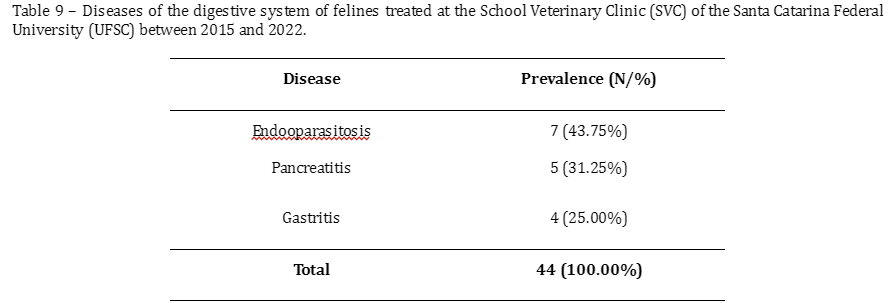Casuistry of canine and feline care at the School Veterinary Clinic of UFSC Curitibanos, Santa Catarina, Brazil, between 2015 and 2022
DOI :
https://doi.org/10.21708/avb.2024.18.2.12201Résumé
This study aimed to survey casuistry from the analysis of clinical and feline clinical tokens attended between 2015 and 2022, at the UFSC School Veterinary Clinic (CVE/UFSC), to obtain a disease prevalence study associated with data of patient reviews. This is the first clinical prevalence study of the state of Santa Catarina and, considering the first seven years of care, were diagnosed diseases in seven organic systems, namely skeletal, respiratory, digestive, reproductive, urinary, nervous and endocrine, and Six specialties such as dermatology, ophthalmology, infectious diseases, dentistry and oncology. Of the 1419 animals served, 74.2% (1053) were canines and 25.8% (366) felines. Of the 1053 dogs, 23.5% (250) were pure races and 76.5% (803) were mestizo. Among the cats, 89.6% (328) were without defined breed and 10.4% (38) of pure races. Regarding ages, most canines had between 10 months and 4 years, while in felines, most of them had up to 1 year of age. In canines there was greater prevalence of dermatological involvement, corresponding to 26.6%, while in felines prevailed problems in the urinary system (15.3%). Casus studies are important for the predominant diseases to be known in a given area and their risk factors, thinking of differential diagnosis and future prevention programs aimed at the well-being and health of animals.
Téléchargements

Téléchargements
Publié-e
Numéro
Rubrique
Licence
(c) Tous droits réservés Acta Veterinaria Brasilica 2024

Cette œuvre est sous licence Creative Commons Attribution 4.0 International.
Autores que publicam na Acta Veterinaria Brasilica concordam com os seguintes termos: a) Autores mantém os direitos autorais e concedem à revista o direito de primeira publicação, com o trabalho simultaneamente licenciado sob a Licença Creative Commons Attribution que permite o compartilhamento do trabalho com reconhecimento da autoria e publicação inicial nesta revista. b) Autores têm autorização para assumir contratos adicionais separadamente, para distribuição não-exclusiva da versão do trabalho publicada nesta revista (ex.: publicar em repositório institucional ou como capítulo de livro), com reconhecimento de autoria e publicação inicial nesta revista. c) Autores têm permissão e são estimulados a publicar e distribuir seu trabalho online (ex.: em repositórios institucionais ou na sua página pessoal) a qualquer ponto antes ou durante o processo editorial, já que isso pode gerar alterações produtivas, bem como aumentar o impacto e a citação do trabalho publicado (Veja O Efeito do Acesso Livre).


 Esta obra está licenciada com uma Licença
Esta obra está licenciada com uma Licença 